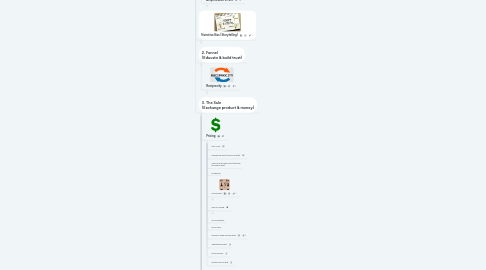
1. Curiosity Tendency
1.1. Open Loop
1.2. Curiosity Gap
1.3. Ambiguity
2. Classical Conditioning
2.1. Repetition
2.2. Triggering positive emotion
2.3. Priming
2.4. Anchoring
3. 1. Advertisement (Capture attention)
3.1. Contrast, Novelty & Surprise
3.1.1. Senses
3.1.1.1. Sight
3.1.1.1.1. Types Of Contrast
3.1.1.1.2. Biases
3.1.1.2. Sound
3.1.1.2.1. Fast vs Slow
3.1.1.2.2. Quiet vs Loud
3.1.1.2.3. Low vs. High
3.1.1.2.4. Location
3.1.1.2.5. Direction
3.1.1.2.6. Pitch
3.1.1.2.7. Tonality
3.1.1.2.8. Timbre
3.1.1.2.9. Pauses
3.1.1.2.10. Cadence
3.1.1.3. Touch
3.1.1.3.1. Location
3.1.1.3.2. Smooth vs. Rough
3.1.1.3.3. Hard vs. Soft
3.1.1.3.4. Hot vs. Cold
3.1.1.3.5. Size: Big vs Small
3.1.1.3.6. Still vs Moving
3.1.1.3.7. Light vs Heavy
3.1.1.4. Taste
3.1.1.4.1. Bitter vs. Sweet
3.1.1.4.2. Hot vs. Cold
3.1.1.5. Smell
3.1.2. Counterintuitive Ideas
3.1.2.1. True vs. False
3.1.2.1.1. Thought Was True, But Is False
3.1.2.1.2. Thought Was False, But Is True
3.1.2.2. Good vs Bad
3.1.2.2.1. Thought Was Bad, But Is Good
3.1.2.2.2. Thought Was Good, But Is Bad
3.1.2.3. Crazy vs. Normal
3.1.2.4. Possible vs Impossible
3.1.2.5. Random Vs Ordered
3.1.2.6. Specific vs General
3.1.2.7. Taboo vs. Normal
3.1.2.8. Under-Estimated vs. Over-Estimated
3.1.2.9. Conflict vs Getting Along
3.1.3. Copywriting
3.1.3.1. Before vs After (Product Impact)
3.1.3.1.1. Hair Loss Example
3.1.3.1.2. Weight Loss Example
3.1.3.1.3. Bill.com
3.1.3.2. You vs Competitors (Differentiation)
3.1.3.3. Now vs. Future (Product Impact)
3.1.4. Words
3.1.4.1. $100 Words
3.1.4.2. Trademark Ideas
3.2. Mere Exposure Effect
3.3. Authority Bias (Celebrity Effect)
3.3.1. Influence By Mere Association (Classical Conditioning)
3.3.2. Social Learning Theory
3.3.3. Halo Effect
3.4. Framing
3.4.1. Brand Bias
3.4.2. Metaphor
3.4.3. Brand
3.5. Amplification Effect
3.5.1. Hopes
3.5.1.1. Power
3.5.1.2. Achievement
3.5.1.3. Affiliation
3.5.1.4. Spirituality
3.5.2. Fears
3.5.2.1. Power
3.5.2.2. Achievement
3.5.2.3. Affiliation
3.5.2.4. Spirituality
4. 2. Funnel (Educate & build trust)
4.1. Narrative Bias (Storytelling)
4.1.1. Characters the customer can relate to
4.1.2. Plot of how the character gets what they want and avoids what they don't want
4.1.3. Narrative momentum
4.2. Reciprocity
4.2.1. Education
4.2.1.1. Liking
4.2.1.1.1. In-group Bias (Relability)
4.2.1.1.2. Treating The Other Like A Friend
4.2.1.1.3. Pratfall Effect (Vulnerability)
4.2.1.1.4. Complimenting Your Audience
4.2.1.1.5. Physical Attractiveness
4.2.1.1.6. Mere Exposure Effect
4.2.1.2. Authority Bias
4.2.1.3. Blockbuster Effect
4.2.2. Free Trial
4.2.2.1. Consistency & Commitment
4.2.2.1.1. Foot in the door technique
5. 3. The Sale (Exchange product & money)
5.1. Pricing
5.1.1. Zero Cost
5.1.2. Investment Bias (Sunk Cost Bias)
5.1.3. Good Money After Bad (Irrational Escalation Bias)
5.1.4. Anchoring
5.1.5. Price Effect
5.1.5.1. If you have a low price product, it might be worth explaining why it's less expensive
5.1.6. Pain Of Paying
5.1.6.1. If your product is more expensive than others, take the time to explain why it is a premium product.
5.1.6.2. SOLUTION: Bundling
5.1.7. Price Elasticity
5.1.8. Price Cliffs
5.1.9. Round Number Discounting
5.1.10. Magnitude Effect
5.1.11. Price Primacy
5.1.12. Mental Accounting
5.2. Social Proof
5.2.1. Types
5.2.1.1. Testimonial
5.2.1.2. Case Study
5.2.1.3. Reviews & Ratings
5.2.1.4. Featured Customer List
5.2.1.5. Expert Review
5.2.1.6. Referral
5.2.1.7. Certification
5.2.2. Examples
5.2.2.1. bartenders prime their tip jar with a few dollars
5.2.2.2. Canned Laughter
5.2.2.3. car manufacturers claim “the number 1 selling truck in America”
5.2.2.4. “Our new toothbrush is recommended by 80% of dentists.”
5.2.3. Additives
5.2.3.1. Quantity of other people
5.2.3.2. Authority of other people
5.2.3.3. Relatability of other people
5.2.3.4. Quantified value
5.2.4. Related Biases
5.2.4.1. Bandwagon Effect
5.2.4.2. Belonging Bias
5.2.4.3. In-Group Bias
5.3. Value Perception
5.3.1. Easy
5.3.2. Present Bias (Hyperbolic Discounting)
5.3.3. Tangible
5.3.4. Certainty Effect
5.3.4.1. Ambiguity Aversion
5.3.5. Amplitude Bias
5.4. Serial Position Effect
5.5. Duration Heuristic
5.6. Status Quo Bias
5.6.1. Loss Aversion
5.6.2. Endowment Effect
5.6.3. IKEA Effect (Not-Invented-Here Syndrome)
5.7. Packaging
5.7.1. Expectancy Theory
5.7.2. Branding
5.8. Scarcity (Urgency)
5.8.1. Limited Availability
5.8.2. Time-Sensitivity (Deadline)
5.8.3. Differentiation From Competitors
5.9. Context Effect
5.9.1. Options
5.9.1.1. Choice Overload
5.9.1.2. Compromise Effect (Decoy Effect)
5.9.1.2.1. SOLUTION: Offer a high-end product to make your previous high-end product seem lower price
5.9.1.3. Relativity Bias
5.9.1.3.1. SOLUTION: Try a “Not-So-Good” Decoy to Push Your Top Product
5.10. Cognitive Dissonance
5.10.1. FOMO
5.10.2. Sharing consequences of not taking action
5.10.3. Sharing downsides of existing approaches
